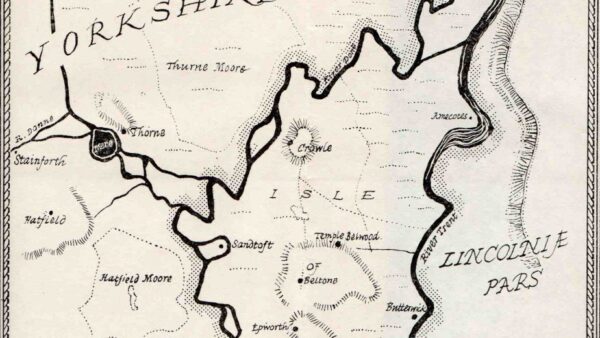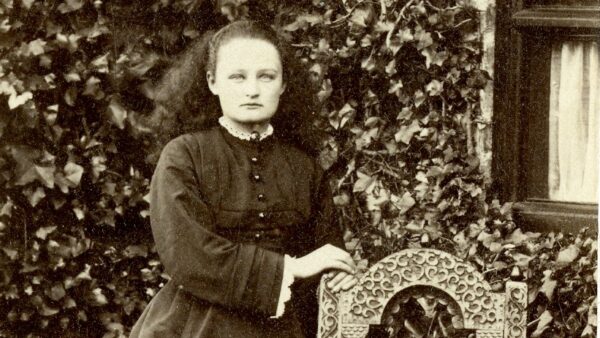Placement at the Museum – the Final Update
Kathryn Bullen, University of Nottingham
What Has Been Happening?
As I reach the end of my placement at the Museum, this is a good time to reflect on what has been happening. Here I give a summary of achievements over the last few months. The placement was funded by Midlands4Cities, part of the Arts and Humanities Research Council, from October 2021 to October 2022. One of the main benefits of spreading the 3-month placement part-time over 13 months was that I was able to appreciate the full process of organising, managing and delivering an exhibition.
I joined the project team in October 2021. Since then I have helped to organise the exhibition on the Isle of Axholme and Hatfield Chase Landscape Partnership. This gave me the opportunity to share some of my place-name research alongside a celebration of the great work of the Partnership. Over the last 5 years of the partnership, projects have helped to reconnect the local community with their unique local landscape and heritage. The exhibition opened in March 2022 and is open until 9 October 2022. It can be visited in person or viewed online via the Virtual Tour.
The first 6 months of the placement were spent developing accessible materials and designing the exhibition space. Work done in conjunction with the Museum and liaising with other members of the project team. I designed 5 panels of place-name related material. These were written according to accessible museum exhibition guidelines. The focus was firmly on collaborative planning and working, culminating in the installation of the exhibition.
I also contributed a chapter to the 124-page booklet ‘Discovering Hatfield Chase and the Isle of Axholme’, edited by Dr Nicola Whitehouse and Joel Karhapää from the University of Glasgow. The booklet was an outcome from Project Wildscape. Chapters were written by volunteers from this project as well as more broadly. My chapter looked at the evidence for Vikings in Axholme which can be found in place-names and archaeological finds at Haxey and Crowle in the Isle of Axholme.

The Website
To complement the exhibition, I created a website with a focus on Axholme place-names. The aim being to encourage online engagement with the exhibition. The website includes a clickable map of place-names, related historical information, and downloadable educational material. The website has been particularly successful in engaging a large number of people virtually, both locally and from around the world. With the added bonus of making my research accessible without having to be physically present at the Museum. To date the website has attracted 1,216 visitors and 5,105 views, with 266 downloads of material. Do take a look and explore the website, if you have not done so already!

Talks and Workshops
After the exhibition opened, the remaining 7 months have been spent on engaging the wider community with the project. I have particularly enjoyed developing and running the complementary programme of talks. Including helping to develop the Museum’s use of hybrid technology when presenting talks to encourage wider participation. Four talks by local historians were planned, covering drainage, Axholme place-names, the Mowbray family, and industrial heritage. You can access these talks again here.
The programme also included two creative writing workshops run by local authors: one for adults and one for children. The creative writing workshop for adults focussed on walking and writing the Axholme landscape, exploring writings by Brian Lewis of a series of walks in North Axholme. The children’s creative writing workshop focussed on material from Addy Farmer’s book ‘Little Peat’. This is the story of a peatland engine, rooted in the industry and landscape of Crowle and Hatfield moors near to where she lives. Children enjoyed making a flying chiffchaff, one of the birds found in moorland Axholme, exploring the tale of the Tiddymun and crafting their own moors monster.

Living History Family Fun Day
One of the highlights of my placement was organising the Viking contribution to the Living History Family Fun Day on 29 July 2022. The event attracted over 800 visitors. It included 20 Viking reenactors setting up camp, demonstrating activities ranging from combat displays and weaponry to drop spinning and net making. Craft activities included bead bracelet/necklace making, creating a Viking ship, and exploring runes. I also had the chance to be interviewed alongside Rose Nicholson, Heritage Manager, by BBC Radio Humberside’s Naj Modak. Large numbers of the public were engaged in re-enactment activities, finding out about how people lived and worked. The event also provided an important link with the Old Norse, Scandinavian language of the Vikings, place-names displayed on my panels inside the exhibition at the Museum.

Thanks!
The museum placement has definitely helped me to achieve my aim of making my research reach a wider audience in the local community and beyond, promoting a greater appreciation for the Axholme landscape and its place-names. As well as proving to be a valuable opportunity to develop skills and knowledge in exhibition design and project management, the placement has provided excellent experience working within a local authority museum environment.
Huge thanks go to Rose Nicholson, my placement supervisor, as well as the Isle of Axholme and Hatfield Chase Landscape Partnership team, and members of the Exhibitions team within North Lincolnshire Museum, who have all made me feel so welcome. Thanks also go to my PhD supervisors, Jayne Carroll and John Baker at the University of Nottingham and Richard Jones at the University of Leicester, for their encouragement and support.
What Next?
After the Museum exhibition ends many of the information panels will be going ‘on tour’ at various venues on the Isle of Axholme. I will continue sharing my research findings with heritage organisations locally and beyond. I am also looking forward to the next stage in my research journey – to finish my PhD thesis and explore further opportunities in heritage and project management!
Useful Links
University of Nottingham research page



Focus On

Placement at the Museum – Place-Names on the Isle of Axholme
What is it like to work behind the scenes at a museum? As a PhD place-name researcher at the University of Nottingham, I wanted to find out more.
Read the story
Placement at the Museum – Researcher’s Update
Find out what has been happening being the scenes, and what is coming up.
Read the story
A Book-larnt Linkisheere Lass
Guest contributor Tim Davies attempts a character sketch of Mabel Peacock.
Read the story